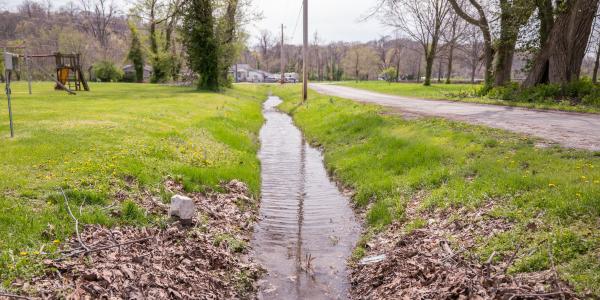Funding from the National Science Foundation will enable researchers in anthropology, hydrology, microbiology, data science, and environmental engineering to advance ongoing research into the damaging health effects of repeated flooding in Metro East communities.
A cross-disciplinary team of WashU researchers has received a five-year, $3.6 million grant from the National Science Foundation to expand its work studying the human health effects of flooding in communities in the Mississippi Delta and the St. Louis Metro East region of Illinois.
The Growing Convergence Research grant — which includes initial funding of $1.2 million with the potential for $2.4 million in subsequent years — will allow the team to create a comprehensive dataset and conduct geospatial analysis to examine the links between flooding, pathogen levels, and infection risk.
“This grant isn’t about looking at 100-year floods that cause FEMA to mobilize,” said Theresa Gildner, assistant professor of anthropology and principal investigator of the project. “We’re focusing on nuisance flooding that really impacts people’s lives.”
The team includes researchers in four Arts & Sciences departments: Gildner in anthropology; Liz Mallott, assistant professor of biology; Claire Masteller, assistant professor of Earth, environmental, and planetary sciences; and Bo Li, the Stanley A. Sawyer Professor of Statistics & Data Science. Fangqiong Ling, an assistant professor of energy, environmental and chemical engineering in McKelvey is also a co-principal investigator.

Gildner, Mallott, and Masteller have been working together since 2023, when they received a seed grant from Arts & Sciences’ Transdisciplinary Institute in Applied Data Sciences (TRIADS) to study the intertwined threats of floods and communicable diseases in Cahokia Heights, a community just 20 minutes east of the Danforth Campus. When it rains, flooding causes sewage to back up into residents’ homes, leading to environmental and health concerns.
Initial funding from TRIADS allowed the team to gather preliminary data showing clear signs of parasitic and bacterial infections in Cahokia Heights residents. They also continued flood monitoring efforts throughout the community, which Masteller’s group began in 2020, and developed a model to predict future floods. These observations made it possible to relate the frequency and severity of flood exposure to resident health, gut microbiome composition, and pathogens in the soil.
One of the bacterial pathogens, H. pylori, can cause ulcers and raise the risk of certain cancers in severe cases. Gildner’s studies have also documented high levels of intestinal inflammation, a clear sign that contamination is taking a toll.
By collaborating with Mallott, the team has been able to identify how exposure to floodwater can shape a person’s microbiome, the trillions of gut bacteria that play a crucial role in health and disease. She is now collecting soil samples across Cahokia Heights to identify pathogenic bacteria and other contaminants that might explain why floodwater is so harmful to human gut health.
“By combining all of our different skill sets, we’re able to look at this question in new ways and generate new data sets that combine various aspects across our different fields and answer these questions in more powerful ways.”
— Theresa Gildner
Masteller, a geoscientist, has studied the flooding risks block by block, work that’s made it possible to identify and predict specific households most likely to be contaminated by sewage. Her community-engaged research approach has demonstrated the pervasive nature of the flooding and the toll it takes on residents. And Ling, an expert in microbial biofilms and water system safety, is examining which germs might be lurking in the residents’ tap water.
With the addition of Li — a leading expert in the big data of rainfall, flooding, and other aspects of climate — the team will be able to take their work to the next level. Li will use her statistical knowledge to help predict future flooding hazards and estimate the benefits of any upgrades to infrastructure.
“By combining all of our different skill sets, we’re able to look at this question in new ways and generate new data sets that combine various aspects across our different fields and answer these questions in more powerful ways,” Gildner said.
The NSF grant will allow the team to create a detailed database, run advanced statistical modeling, and develop an interactive risk map that helps communities assess their vulnerabilities and evaluate mitigation strategies. The team also plans to develop training workshops, citizen science initiatives, and publicly accessible tools that can help predict and manage flood-related health hazards nationwide.
“We know that Cahokia Heights isn't the only community that's being impacted by these issues, and that it's going to continue with climate change, making storms and flooding worse across the U.S. in the coming years,” Gildner said. “Academics have the resources, the expertise, and the labs to help these communities — especially in lower resource areas like Cahokia Heights — assess the issues going on in their community and to give them data they can use to address social problems.”
Header image: Flooding in Cahokia Heights, Illinois. Photo by Sean Garcia for WashU.





